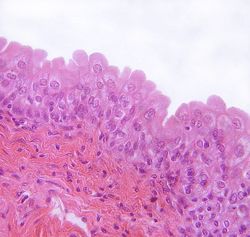Transitional epithelium
| Transitional epithelium | |
|---|---|
 | |
| Transitional epithelium of the urinary bladder. Note the rounded surface of the apical cells -- a distinguishing characteristic of this type of epithelium. | |
 | |
| Transverse section of ureter. | |
| Code | TH H2.00.02.0.02033 |
Transitional epithelium (also known as urothelium) is a type of tissue consisting of multiple layers of epithelial cells which can contract and expand. These cells, part of the epithelium, are found in the urinary bladder, in the ureters, and in the superior urethra and gland ducts of the prostate.
Appearance
These cells appear to be cuboidal with a domed apex when the organ or the tube in which they reside is not stretched. When the bladder fills, the tissue actually compresses and the cells become stretched, and they appear to be flat, irregular, and squamous. Middle layer pear shaped, basal layer has ability to stretch.
Functions
The transitional epithelium cells accommodate fluctuation of volume of the liquid in an organ or tube, such as the urinary bladder, and protect against the caustic effects of urine. Location : Starting from renal pelvis in kidneys to ureters → to urinary bladder → and finally to proximal part of urethra. (Note that the distal part of the urethra becomes non-keratinized stratified squamous epithelium in females, and in males it becomes pseudo-stratified columnar epithelium briefly before becoming non-keratinized stratified squamous epithelium.)
Surfaces
The free surface of the tissue (the part that faces outward into the organ or tube) is called the apical surface or free surface.
The part that lines the bottom of the tissue is called the basement membrane.
Gallery
-

Types of epithelium
-

Schematic view of transitional epithelium
-

Vertical section of bladder wall.
See also
External links
- Histology at utmb.edu
- Histology at OU 36_02 - "ureter"
- Histology at OU 37_02 - "urinary bladder"
- Anatomy Atlases - Microscopic Anatomy, plate 02.24 - "Transitional Epithelium", Ureter
- Histology at KUMC urinary-renal16 "ureter"
| |||||||||||||||||||||||||||